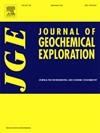Geochemistry, geochronology and Fe-Mg-S isotopic composition of the Liaoshang gold deposit, Jiaodong Peninsula, China: Implications for ore-forming processes and mineral exploration
IF 3.3
2区 地球科学
Q1 GEOCHEMISTRY & GEOPHYSICS
引用次数: 0
Abstract
The Liaoshang Au deposit in North China is distinguished by gold occurrence in pyrite-dolomite veins and characterized by large Au endowment (about 69 t Au @ 3.3 g/t), representing a novel gold deposit type within the Jiaodong gold province. To date, the mineralization age and metallogenic mechanism remain controversial, limiting the in-depth understanding of ore-forming processes. The Liaoshang Au mineralization differs from classic orogenic Au metallogeny in close relationships with the occurrence of ore-stage pyrite and dolomite. Here, we use syn-ore stage monazite U-Pb geochronology to constrain the ore-forming age. We also measured Fe and Mg isotope compositions in pyrite and dolomite associated with gold mineralization, combined with in situ LA-(MC)-ICP-MS elemental mapping and S isotopes in pyrite to decipher the iron, magnesium, and sulfur source(s), aiming to provide new insights into the ore-forming processes. Petrographic observation shows that gold in pyrite-dolomite veins mainly occurs as micro-grains (20–100 μm) within pyrite. Elemental mapping and in situ S isotope measurements for pyrite indicate that the main Au mineralization is associated with elevated concentrations of Cu, Ag, As, and Bi, as well as heavy sulfur isotope values (δ34S ~13.6 ‰, compared to ~8.0 ‰ in the early stage). This is attributed to the addition of sulfur with high δ34S from the basement Jingshan Group. The δ56Fe values of ankerite and pyrite present a narrow range with an average of −0.21 ‰ and +0.56 ‰, respectively. The inverse enrichment of iron isotopes between ankerite and pyrite may be attributed to thermodynamic equilibrium fractionation in an open system. The δ26Mg values of ankerite yields a wide range from −3.02 ‰ to −0.80 ‰. By comparing the Fe and Mg isotopic signatures of ores with those of local granites and basement rocks, we argue that the Jingshan Group contributed Fe and Mg to form auriferous pyrite and dolomite. The U-Pb dating of monazite in Au-bearing pyrite yields an age of 118.8 ± 1.7 Ma, which may represent the mineralization age of the deposit. The ore-forming fluid sourced from metasomatized mantle lithosphere leached Fe, Mg, and some heavier sulfur from the Jingshan Group to precipitate pyrite and dolomite in Liaoshang, forming pyrite‑carbonate veins. This is a critical gold mineralization mechanism for forming the Liaoshang-type gold deposits in the Jiaodong Peninsula, North China, which is different from that of the Jiaojia-type (disseminated stockwork-altered wall-rock type) and Linglong-type (quartz-sulfide vein type) gold deposits.

胶东半岛辽上金矿床地球化学、年代学及铁镁硫同位素组成:成矿过程与找矿意义
辽上金矿床以黄铁矿-白云岩脉状金赋存为特征,金赋存量大(约69 t,品位3.3 g/t),是胶东金省一种新型金矿床类型。迄今为止,成矿年龄和成矿机制仍存在争议,限制了对成矿过程的深入认识。辽上金成矿作用与经典造山带金成矿作用不同,与矿期黄铁矿和白云岩的赋存关系密切。本文利用同矿期独居石U-Pb年代学对成矿时代进行了约束。我们还测量了与金矿化有关的黄铁矿和白云岩中的Fe和Mg同位素组成,并结合原位LA-(MC)- icp - ms元素测绘和黄铁矿中的S同位素来解读铁、镁和硫的来源,旨在为成矿过程提供新的见解。岩石学观察表明,黄铁矿-白云岩脉中的金主要以微细颗粒(20 ~ 100 μm)形式赋存于黄铁矿中。黄铁矿元素填图和原位S同位素测量结果表明,金的主要成矿作用与Cu、Ag、As和Bi的富集及重硫同位素值(δ34S ~13.6‰,早期为~8.0‰)升高有关。这主要是由于井山群基底中δ34S高的硫的加入。铁云母和黄铁矿的δ56Fe值范围较窄,平均值分别为- 0.21‰和+0.56‰。铁同位素在铁云母和黄铁矿之间的反向富集可能归因于开放体系中的热力学平衡分馏。铁白云石的δ26Mg值在−3.02‰~−0.80‰之间。通过与本区花岗岩和基岩的铁、镁同位素特征对比,认为景山群为含金黄铁矿和白云岩提供了铁、镁同位素。含金黄铁矿中独居石的U-Pb测年结果显示,独居石的年龄为118.8±1.7 Ma,可能代表了矿床的成矿年龄。来自交代地幔岩石圈的成矿流体浸出了景山群的铁、镁和部分较重的硫,使辽上黄铁矿和白云岩沉淀,形成碳酸黄铁矿脉。这是胶东半岛辽上型金矿床形成的关键成矿机制,不同于胶东半岛焦家型(浸染网-蚀变围岩型)和玲珑型(石英-硫化物脉型)金矿床。
本文章由计算机程序翻译,如有差异,请以英文原文为准。
求助全文
约1分钟内获得全文
求助全文
来源期刊

Journal of Geochemical Exploration
地学-地球化学与地球物理
CiteScore
7.40
自引率
7.70%
发文量
148
审稿时长
8.1 months
期刊介绍:
Journal of Geochemical Exploration is mostly dedicated to publication of original studies in exploration and environmental geochemistry and related topics.
Contributions considered of prevalent interest for the journal include researches based on the application of innovative methods to:
define the genesis and the evolution of mineral deposits including transfer of elements in large-scale mineralized areas.
analyze complex systems at the boundaries between bio-geochemistry, metal transport and mineral accumulation.
evaluate effects of historical mining activities on the surface environment.
trace pollutant sources and define their fate and transport models in the near-surface and surface environments involving solid, fluid and aerial matrices.
assess and quantify natural and technogenic radioactivity in the environment.
determine geochemical anomalies and set baseline reference values using compositional data analysis, multivariate statistics and geo-spatial analysis.
assess the impacts of anthropogenic contamination on ecosystems and human health at local and regional scale to prioritize and classify risks through deterministic and stochastic approaches.
Papers dedicated to the presentation of newly developed methods in analytical geochemistry to be applied in the field or in laboratory are also within the topics of interest for the journal.
 求助内容:
求助内容: 应助结果提醒方式:
应助结果提醒方式:


